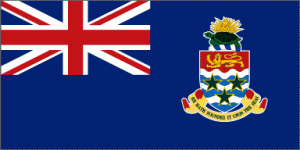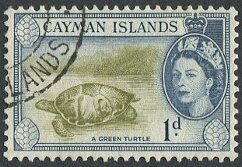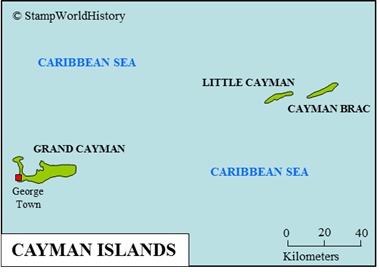
Cayman Islands
Quick reference
General issues: British colony/Dependency Jamaica 1901-1959, British colony/West Indies Federation 1959-1962, British colony 1962-1981, British dependency 1981-2002, British overseas territory 2002-Present
Country name on general issues: Cayman Islands
Currency: 1 Pound = 20 Shilling, 1 Shilling = 12 Pence 1901-1969, 1 Dollar = 100 Cents 1969-Present
Population: 5 300 in 1901, 58 400 in 2013
Political history Cayman Islands
The Cayman Islands are located in the Caribbean – for the exact location, please refer to the map of the Caribbean. Prior to colonization the islands were uninhabited. The first European to sight the islands was Christopher Columbus in 1503. The islands were formally claimed by and awarded to Britain in 1670. In the 1730’s, the first permanent settlements were established. The islands were, from 1670, de facto administered from Jamaica and in 1863 became a de jure dependency of Jamaica. The Cayman Islands would be administered as such until 1959, when they became a separate colony – from 1962 a crown colony. In 1959, the Cayman Islands joined the West Indies Federation – a short lived federation of British possessions in the Caribbean that existed from 1958 until 1962. The Cayman Islands became a British dependency in 1981 and a British overseas territory in 2002. Currently, the Cayman Islands have an elected parliament and a premier appointed by the governor.
Economically, the Cayman Islands were little developed until the mid 20th century when tourism and off shore financial services were developed. Currently, tourism accounts for 70% of the GDP. The Cayman Islands rank as the fifth most important off shore financial center in the world. Tourism and off shore financial services have made the Cayman Islands one of the wealthiest countries in the Caribbean – in terms of per capita GDP, ranking 35th out of 230 countries in the world. People of mixed origin account for 40% of the population, blacks for 20% and whites for 20%. Expatriates of various ethnic groups account for the remaining 20%.
Postal history Cayman Islands

1953-1959 – Green turtle. The Cayman Islands were named Las Tortugas by the Spanish after the many turtles on the islands.
The first stamps were issued for the Cayman Islands in 1901. Prior to that, stamps of Jamaica were used. The stamps issued in the classical period are of designs common to the British colonies. The Cayman Islands joined in some of the omnibus issues for the British colonies. In the modern era, the stamps issued by the the Cayman Islands are a blend of themes of national interest and themes aimed at the thematic collectors market.
Album pages
← Previous page: Caribbean NetherlandsNext page: Chile →




